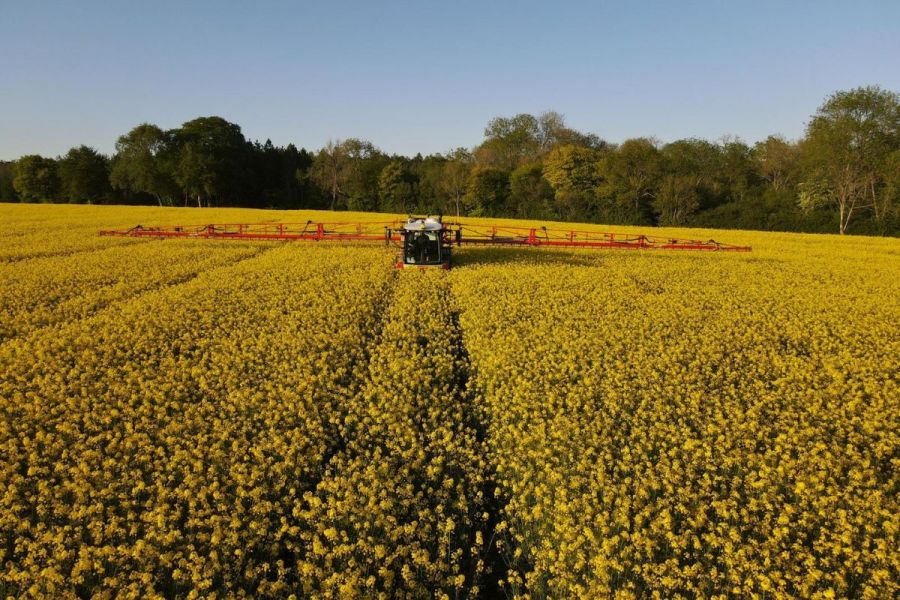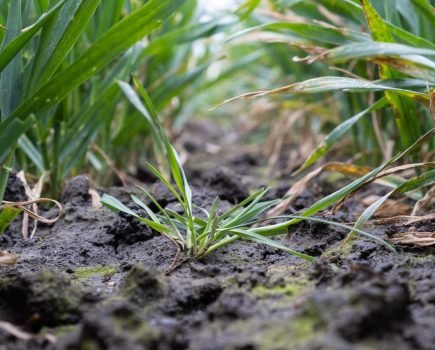Amid a constant battle with declining chemistry and catchy weather windows, including an adjuvant in the spray tank is proving essential for one Wiltshire spray operator. CPM finds out more.
“Why wouldn’t you be enhancing chemistry if you’re able to in order to the get the best performance you can?”
By Charlotte Cunningham
At Clarendon Park Farms in Salisbury, quiet days are few and far between for farm manager James Kelsey.
James oversees the management of 1820ha, operating as a mixed farming system with 405ha of woodland, 1011ha of arable and 390ha down to pasture for the South Devon cross Red Angus cattle enterprise, with animals finished for Dovecote Park, supplying Waitrose with Angus beef.
“On the arable side we’re growing winter wheat, winter barley and spring barley, with break crops of winter beans or oilseed rape once every three to four years, as well as a winter cover crop of buckwheat, crimson clover, berseem clover, vetch and phacelia ahead of spring drilling,” says James.
“We make the most of our grass leys on the farm, mob-grazing the cattle over 20ha, split into 2ha areas, which we then back fence as they’re moved on. On our flintier soils, we use sheep to graze the covers over winter.”
Being mostly light chalk soils, farming the estate comes with challenges, he continues. “We’re asking a lot from our soils. But healthy soils are intrinsically linked to plant health so we’ve focused on improving them for some time.”
“We’ve been operating min-till for a long time and working to improve soil structure and organic matter levels, aided by organic manure from the livestock and a straw-for-muck deal with a local dairy farmer.”
As well as this, James and the team put a lot of effort into testing and monitoring soil health with help from their Agrii agronomist, Todd Jex. “Other than normal soil testing every year, we’re also testing once every four years, digging a soil pit in various fields on the estate, which we geotag with Agrii’s Rhiza software, enabling us to go back to the exact spot in four years time,” says James. “We’re checking worm counts, infiltration rates, VESS assessments, organic matter levels and other key indices to measure the impact of our action plan.
“When we tested the fields last year, some were around 3.5% organic matter,” he continues. “So it’s a work in progress, but average across the farm is around 6% which I think is pretty good.”
This approach goes hand-in-hand with a focus on optimising inputs and using only what they have to. “We’ve not been using insecticides for a while now, and we’re starting to reduce our fungicide inputs where we can,” says James. “But what we do apply, we make sure goes on well and it works.”
Heading up the spray application programme is operator Jason Winning, who believes that incorporating an adjuvant is vital to getting the best from his applications. “Chemistry isn’t as good as it used to be, so why wouldn’t you be enhancing it if you’re able to in order to the get the best performance you can? That’s where the right adjuvant can more than pay for itself, and for me Kantor ticks that box well.”
Kantor, from Interagro, is an all-in-one activator and special purpose adjuvant, which is claimed to improve tank mix compatibility, buffer spray water to pH 6-7, reduce spray drift, and enhance overall product effectiveness by increasing coverage, adhesion and penetration across plant surfaces. “In fact, it’s the only one-can adjuvant solution on the market that alleviates risk across the entire spraying operation – from tank mixing, through to spraying and even down to action on target plants,” says Stuart Sutherland, technical manager at Interagro. “Its for these reasons Kantor is of one of the most widely used adjuvants in the spring, because it ticks the box on so many levels.”
Jason is a self-proclaimed ‘huge fan’ of the adjuvant, and says there are three main situations where he always runs with Kantor: in catchy weather, when there are multiple products in the tank, and when chemistry performance has to be optimised. “The crop protection products we’re using cost a lot of money so it makes sense to get the most out of them as much as we can.”
Delving deeper into the challenge of catchy, difficult spraying conditions, being on the edge of Salisbury Plains means the winds can whip through the valley which makes spraying with a 5000 litre Agrifac Condor 36m sprayer quite a challenge. “We have a large acreage to cover in quite often a short weather window, so the drift reducing properties of Kantor essentially buys me more time to get sprays on.
“We also have a lot of trees and shady areas on the estate which can hold the dews, adding to the challenge of keeping product on the leaf. This is particularly problematic with contact herbicides. But Kantor improves retention on the leaf, and you can see much better coverage.”
This better coverage comes down to Kantor’s ability to manipulate droplet size which helps crop protection products to spread out and adhere to the leaf surface more effectively, explains Stuart.
“In essence, adding in the Kantor reduces the number of <100 micron spray droplets – which are most susceptible to drift – and the number of very corase droplets, which are prone to bounce, creating a droplet size that is optimal in size for more precise and targeted application.
“When the water droplets containing the dissolved active ingredients hit the leaf surface, the Kantor reduces the high surface tension, enabling them to spread out rather than rolling off the leaf, so they cover it properly and can be retained.”
These benefits of enhanced coverage are particularly useful for challenging leaf surfaces, notes Jason. “We’ve inherited a bit of a sterile brome problem which we’re currently working on tackling. If you give it an inch it will take a mile, so making sure our herbicide application is effective, is really crucial.
“In the autumn we’ll team Pontos (flufenacet+ picolinafen) with the residual herbicide adjuvant Backrow Max to reduce drift and maximise residual activity, and then follow up in the spring with a post-em plus Kantor.
“Brome can be tricky for coverage because of its hairy surface, so we find an adjuvant is crucial in this scenario. This is also important in the OSR with phoma and sclerotinia sprays too, as OSR has a very waxy leaf, so we’ll add the Kantor in with the fungicide to help maximise protection,” he adds.
Optimising coverage across the oilseed rape leaves can be tricky, especially when wet, as the surface tension is even higher, continues Stuart. “So adding in the Kantor is really valuable to create a stronger barrier to the spores, leading to more effective treatment overall.”
But its Kantor’s small molecular size that sets it apart from other adjuvants, enabling better penetration into plants, so active ingredients get to work faster, he says.
“Due to its small molecular packing size at the water (spray droplet) to leaf interface, Kantor is able to ‘concentrate’ the number of active ingredient molecules on the leaf surface, enabling more entry points. One of the other benefits is its ability to allow lateral diffusion, where active can move horizontally in the waxy cuticle.”
This penetration power has been proven in multiple trials, including a study at Wageningen University in The Netherlands using UV tracer dye to look at penetration.
The research showed that Kantor delivered higher concentrations of crop protection into the leaf cuticle – compared with when these products were used alone – resulting in significantly higher uptake into plants.
“With fungicide efficacy waining, enhancing fungicide uptake into the leaf with Kantor has valuable benefits for both disease control and yield, something we’re seeing more and more of in trials,” says Stuart.
“In 2022 Prime Crop Research trials for example, there were significant improvements in septoria control in varieties Wolverine, Gleam and Extase when Kantor was added at T1 and T2. In Agrii trials on the varieties Elation and Elicit, across an average of five different fungicide programmes on each, there was a reduction in disease levels across leaf layers and an uplift in yield, which was significant in the Elicit.”
And it’s when paired with fungicide sprays where James says the duo really gain a lot of reassurance from the Kantor.
“We’ve dropped our T0 fungicide, focusing on trace elements instead to boost plant health. However, our T1 programme on wheat is typically a big mix, so we’ll add Kantor in at this point.
“Last year applications were around 29 April, and the mix included an SDHI, triazole and two PGRs, plus some micronutrients and magnesium. It’s a pretty big mix, but with Kantor you just know it will be fine.
“As well as a complex tank, we are sometimes mixing in cold water which can slow things down,” continues Jason. “We also have hard water and a naturally high pH level which complicates the mixing operation further. Kantor helps here again, buffering and speeding up the mixing process, also improving compatibility, ensuring all products are combined much more thoroughly together in the tank.”
Looking at the science, Stuart explains that as water is a charged polar molecule, variability in water temperature and quality can affect how well products dissolve into it. Any more than three products in the tank increases the risk of a mixing problem, especially if using low water volumes.
“Kantor helps emulsify all the components of the mix, and keep them stable, even in cold water. As well as the time saving benefits for operators, it also reduces the likelihood of a crop safety issue and increases the bioavailability of active ingredients for maximum uptake and performance.”
Looking to the season ahead, like many growers James and Jason are feeling the effects of the washout autumn. “About 80% of the cropping on the chalks looks pretty good, but the other 20% has suffered and we’ve lost some of the area, with crops currently sat in anaerobic soils. Slugs are a big problem at the moment too.”
The second half of February was spent stitching in winter wheat where possible, but the focus now for the spring is getting the most from inputs on what crops do remain, explains James.
“Costs are continually getting higher, and we have to try to keep things on an even keel. As part of this, our long-term goal is to continue to further improve soil health and the efficacy of our inputs, which in turn should help us reduce them where we can. Embracing technology, including adjuvants, to help us do just that.”
“Kantor’s ability to reduce drift and lower rainfast timing gives us the flexibility to extend our working hours in catchy, bad weather seasons and having a reliable robust product which enhances compatibility in tank mixes definitely puts us at ease when applying multiple products,” concludes Jason.
“Having that reassurance not only improves chemical coverage and penetration, but also gives us the security that all products tank mixed will be utilised to their full potential,” he concludes.
This article was taken from the latest issue of CPM. Read the article in full here.
For more articles like this, subscribe here.
Sign up for Crop Production Magazine’s FREE e-newsletter here.




